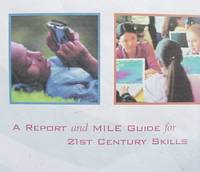
Download this Report.

‘The Learning for the 21stC’ Report well worth downloading.
While nations focus on the literacy and numeracy problems the Report states that there still remains a gap between the knowledge and skills most people learn in school and the knowledge they need for the 21stC. The world has changed dramatically and so must schools.
Fifty years ago factory and office workers worked on a single machine but new powerful technology has altered traditional practices and participating effectively in communities and democracy requires peoples to use more advanced knowledge as well. Most job skills will become obsolete in a few years and workers will have to become life long learners.
Successful businesses are looking for employees who can adapt to changing needs, juggle multiple responsibilities and routinely make decisions for themselves. Future work will be about multi –tasking, teaming, problem solving and project work. Workers need more than know how they also need the ability to create, analyze and transform.
Peter Senge, the futurist asks a simple question, ‘How has the world changed in the past 150 years? And the answer is, it’s hard to imagine any way in which it hasn’t changed. Children know more about what’s going on than their teachers often because the media environment they grow up in. They’re immersed in a media environment of all kinds of stuff that was unheard of 150 years ago, and if you look at school today versus 100 years ago, they are more similar than dissimilar.’
The Report outlines six elements of a 21stC Education.
1. Emphasize core subjects.
2. Emphasize learning skills.
Students need to know how to use their knowledge and skills by thinking critically, applying knowledge to new situations, comprehending new ideas, adjusting to ever changing circumstances; communicating, collaborating with others and solving problems.
3. Use21stC tools to develop learning skills.
Technology will continue to be a driving force in workplaces and in the community. Skilled people need to know how to use technology and multi media tools. Students can from am early age learn to take full advantage of research and multi media tools.
4. Teach and use 21stC contexts.
Teachers need to create 21stC contexts by: making content relevant to student’s lives; bringing the world into the classroom; taking students into the world; and creating opportunities for students to interact with each other and knowledgeable adults. The community can become a learning resource. By these means students can see connections between their schoolwork and their lives outside the classroom. These connections are critical.
5. Teach and learn 21stC content.
It is vitally important that the next generation preserve and strengthen our democracy. This requires understanding of: global awareness and of different cultures, countries and regions ; an understanding of businesses processes, the importance of entrepreneurial spirit, and the economic forces that shape their lives; an understanding of civic literacy and the importance of participating in the political process; and finally ad appreciation of such areas as the visual and performing arts.
6. Use 21stC assessment that measure 21stC skills.
What is measured gets taught; assessment drives instruction. If we are to value project based learning then we need to integrate classroom teaching and assessment including the use of rubrics and self assessment.
These six elements would make an excellent basis to begin a dialogue in your school or community.
They have much in common with the Teaching Framework to be found on our site.
No comments:
Post a Comment